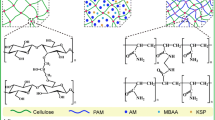Abstract
Cellulose-synthetic polymer nanocomposite films were prepared by immersion of cellulose gel in polymer solutions followed by dry casting. The cellulose hydrogel was prepared from aqueous alkali-urea solution. As the synthetic polymer, polystyrene (PS) and poly(methyl methacrylate) (PMMA) were used. The polymer content could be changed between 10 and 80% by changing polymer concentration of immersing solution. While the mechanical properties of the cellulose-PMMA composite films showed a nearly linear dependence on PMMA content, those of cellulose-PS composites showed an anomalous behavior; both tensile strength and Young’s modulus showed prominent maxima at 15–30 wt% PS contents. This anomaly may have resulted from the specific interaction between the aromatic ring of PS and the hydrophobic plane of the glucopyranoside. Both PMMA and PS composite films showed significant improvements in dimensional thermal stability; up to 25 wt% synthetic polymer content, the coefficient of thermal expansion (CTE) was as low as ca. 30 ppm/K, about 1/3 of the pure polymers. This indicates that the regenerated cellulose network is effective in suppressing thermal expansion of the synthetic polymers.







Similar content being viewed by others
References
Cai J, Zhang L (2005) Rapid dissolution of cellulose in LiOH/Urea and NaOH/Urea aqueous solutions. Macromol Biosci 5:539–548
Cai J, Kimura S, Wada M, Kuga S, Zhang L (2008) Cellulose aerogels from aqueous alkali hydroxide-urea solution. ChemSusChem 1:149–154
Flory PJ (1949) The configuration of real polymer chains. J Chem Phys 17:303–310
Henriksson M, Henriksson G, Berglund LA, Lindstrom T (2007) An environmentally friendly method for enzyme-assisted preparation of microfibrillated cellulose (MFC) nanofibers. Eur Polym J 43:3434–3441
Linder M, Teeri TT (1997) The roles and function of cellulose-binding domains. J Biotechnol 57:15–28
Masson JF, Manley RS (1991) Miscible blends of cellulose and poly(vinylpyrrolidone). Macromolecules 24:6670–6679
Miyashita Y, Nishio Y, Kimura N, Suzuki H, Iwata M (1996) Transition behaviour of cellulose/poly(Nvinylpyrrolidone-co-glycidyl methacrylate) composites synthesized by a solution coagulation/bulk polymerization method. Polymer 37:1949–1957
Miyashita Y, Kimura N, Suzuki H (1998) Cellulose/poly(acryloyl morpholine) composites: synthesis by solution coagulation bulk polymerization and analysis of phase structure. Cellulose 5:123–134
Nakagaito AN, Yano H (2008) The effect of fiber content on the mechanical and thermal expansion properties of biocomposites based on microfibrillated cellulose. Cellulose 15:555–559
Nishio Y (2006) Material functionalization of cellulose and related polysaccharides via diverse microcomposition. Adv Polym Sci 205:97–151
Nishio Y, Hirose N (1992) Cellulose poly(2-hydroxyethyl methacrylate) composites prepared via solution coagulation and subsequent bulk-polymerization. Polymer 33:1519–1524
Nishio Y, Manley RS (1990) Blends of cellulose with nylon 6 and poly(4aprolactone) prepared by a solution-coagulation method. Polym Eng Sci 30:71–82
Samir A, Alloin F, Dufresne A (2005) Review of recent research into cellulosic whiskers, their properties and their application in nanocomposite field. Biomacromolecules 6:612–626
Siro I, Plackett D (2010) Microfibrillated cellulose and new nanocomposite materials: a review. Cellulose 17:459–494
Yamakawa H (1961) Concentration dependence of polymer chain configurations in solution. J Chem Phys 34:1360–1372
Yamane C, Aoyagi T, Ago M, Sato K, Okajima K, Takahashi T (2006) Two different surface properties of regenerated cellulose due to structural anisotropy. Polym J 38:819–826
Author information
Authors and Affiliations
Corresponding author
Rights and permissions
About this article
Cite this article
Isobe, N., Sekine, M., Kimura, S. et al. Anomalous reinforcing effects in cellulose gel-based polymeric nanocomposites. Cellulose 18, 327–333 (2011). https://doi.org/10.1007/s10570-010-9487-6
Received:
Accepted:
Published:
Issue Date:
DOI: https://doi.org/10.1007/s10570-010-9487-6




